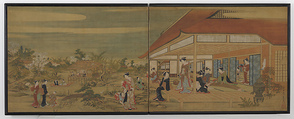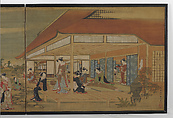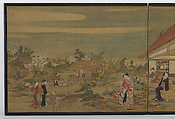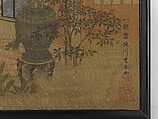Returned to lender The Met accepts temporary loans of art both for short-term exhibitions and for long-term display in its galleries.
Pastimes of a Spring Afternoon
Utagawa Toyoharu Japanese
Not on view
In the mid-eighteenth century, Japanese artists began producing copies of European vues d’optique imported from China, influencing Toyoharu to design miniature perspective views for these optical devices. Later, he redesigned many of these as horizontal prints of landscapes bustling with figures and lavish houses with many rooms opening into the far distance, using the simple one-point perspective he had learned from European engravings. He was also among the first Japanese artists to emphasize landscape or architectonic backgrounds in perspective, in proper proportional relation to the figures in the foreground.
In this two-panel folding tea screen, Toyoharu has used all of these tools to depict an afternoon outing of upper-class Japanese women and their children at a grand residence on the outskirts of a village. Sliding doors have been partly removed to reveal the spacious interior of the mansion where women are playing the koto and shamisen, smoking pipes, and enjoying the spring weather. Cherry trees are in bloom in the vast garden dotted with rustic pavilions into which young children have playfully pulled their mothers, perhaps in hopes of a ride in the boat on the lake.
Due to rights restrictions, this image cannot be enlarged, viewed at full screen, or downloaded.
This artwork is meant to be viewed from right to left. Scroll left to view more.





